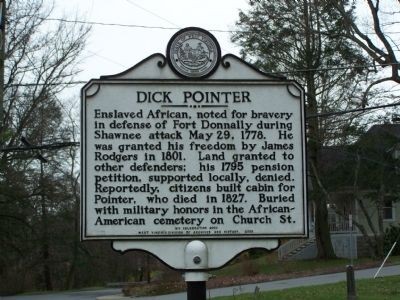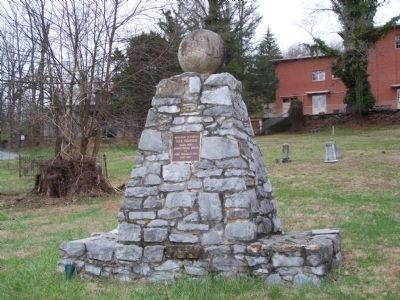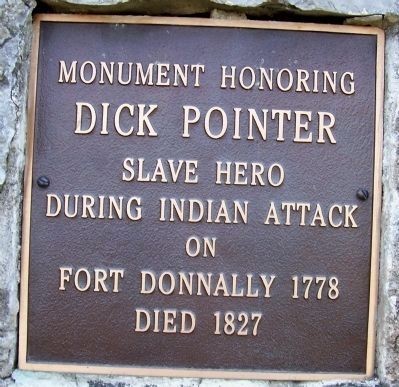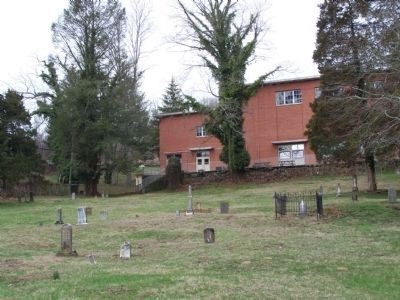Dick Pointer Cemetery
Introduction
Text-to-speech Audio
Images
Dick Pointer Historical Marker

Dick Pointer Monument

Plaque commemorating Dick Pointer

Section of old African-American cemetery in Lewisburg. Photo is of section near Dick Pointer Monument.

Backstory and Context
Text-to-speech Audio
Dick Pointer, an enslaved man, saved countless lives on May 29th, 1778 when he barred the Fort Donnally door from a Native American attack and woke the sleeping inhabitants so they could protect their dwellings and lives. Seventeen years after Pointer’s actions saved Fort Donnally there was a petition for his freedom, but the Virginia General Assembly denied the request. In 1801, James Rodgers purchased Pointer and granted him his freedom. Pointer lived in a cabin, reportedly built by community members, a free man until his death in 1827. Pointer was buried with military honors in this cemetery.
Enslaved under Col. Andrew Donnally, there is not much known about Dick Pointer before the events of 1778.
*From Fort Donnally Clio entry:
"In May 1778, a large group of Wyandot and Mingo Native Americans were sighted crossing the Ohio River just north of the mouth of the Kanawha. They were headed on a raiding party to Greenbrier County in order to steal cattle and attack settlements along the way. Two scouts named Philip Hammond and John Pryor were dispatched from Fort Randolph in Point Pleasant to warn Greenbrier settlements of the impending attack. When the war party had reached Greenbrier County, many of the local residents had heeded the warnings and taken refuge at Fort Donnally, a large two-story fortified double log house surrounded by a rectangular stockade which was garrisoned by local militiamen. On the morning of May 29, an estimated 50 to 300 Natives Americans attacked Fort Donnally where 20 militiamen, under the command of Lt. Colonel Andrew Donnally and Lt. Jack Williams, along with 60 other men, women, and children had taken refuge. The militiamen withstood the initial attack and around three o’clock in the afternoon, reinforcements under the command of Colonel John Stuart arrived from Fort Savannah in nearby Lewisburg. Stuart left a detailed account of the battle.
He stated, when the reinforcements initially arrived at the fort, four men had been killed; two had been killed outside the fort, and two were killed defending the initial attack. The natives had commenced the attack at first light and only Hammond and a slave named Dick Pointer were awake. Stuart writes that the natives had laid their firearms down and made their initial attack with tomahawks and war clubs in hope of surprising the sleeping settlers. Hammond and Pointer held the door while the Natives attempted to destroy it with their hatchets. When the attackers had the door partially opened Hammond killed one with his hatchet and Pointer fired a musket heavily loaded with buckshot at the doorway, halting the attack and alerting the rest of the fort to the attack. Once the other residents of the fort awoke, Stuart claims, “they fired out of the windows on the Indians so briskly, that…seventeen of the Enemy lay dead in the yard, one of whom was a boy about fifteen…”. Later that night, the Natives withdrew after suffering seventeen casualties. On their return to Ohio, they attacked several other small forts in the area with no success."
Due to his large size and powerful nature, Pointer was able to save approximately 70 people, women and children mainly. All this despite as sources at the time claim, that Pointer sought permission to use the flintlock muskets at the fort. His actions made him a hero for the battle and the area. In 1801 he was granted his freedom by James Rodgers but was denied in 1795 his pension of land granted to defenders of Donnally, despite Pointer being supported by the local populace. In turn, the locals built Pointer a cabin, which he lived in until his death in 1827. He was buried in a local African-American cemetery off Church street with military honors.
Sources
Miller, Cathy Hershberger "Dick Pointer." e-WV: The West Virginia Encyclopedia. 08 December 2015. Web. 12 July 2017.
